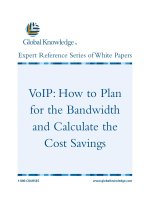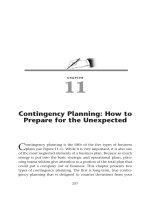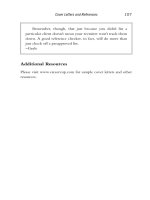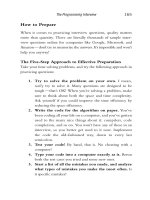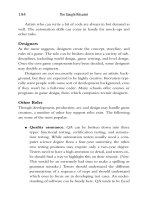VoIP: How to Plan for the Bandwidth and Calculate the Cost Savings
Bạn đang xem bản rút gọn của tài liệu. Xem và tải ngay bản đầy đủ của tài liệu tại đây (298.23 KB, 9 trang )
VoIP: How to Plan
for the Bandwidth
and Calculate the
Cost Savings
1-800-COURSES
www.globalknowledge.com
Expert Reference Series of White Papers
Introduction
The economic drivers for voice and data integration using voice over IP (VoIP) are catching the attention of
CFOs, CIOs and others involved on the cost side of any business. This white paper will show the cost justifica-
tion for voice and data network integration and how much increase in bandwidth will be necessary once voice
traffic is added to the traditional data traffic being carried across a wide area network (WAN).
Before
VoIP
, a network for an institution had two distinct infrastructures—one for voice and one for data:
Bill Treneer, Global Knowledge Instructor, CCSI, SME Cisco Multicasting
VoIP: How to Plan for the Bandwidth
and Calculate the Cost Savings
Copyright ©2005 Global Knowledge Network, Inc. All rights reserved.
Page 2
PBX
PBX
PBX
PSTN
Voice
Network
IP WAN
Data
Network
Data
Router
Data
Router
Data
Router
San Jose
Washington DC.
Houston
W
ith VoIP, a network for an institution has just one integrated infrastructure:
At first glance, it seems that without the PSTN infrastructure the cost justifications for VoIP are simple. While
PSTN usage can be reduced considerably, it cannot be eliminated totally since the PSTN must handle call over-
flow and any calls not destined to the remote sites. Also, the extra voice over IP traffic may cause an increase
in WAN bandwidth. The cost for this extra capacity will have to be subtracted from the savings achieved from
reduced PSTN usage. The step-by-step cost justification example below can be used as a model for other net-
work integration projects.
Step 1
Obtain a busy hour and an overall traffic study from the voice service provider
. Most PBXs provide similar statis-
tics. Use the study to determine the number of hours of voice conversation or Erlangs of voice traffic the new
integrated voice/data network is to handle during the busiest hour of the average day of the busiest month.
Sample Study
Company XYZ has a Frame-Relay connection in San Jose that is a T-1 physical connection with two 256K CIRs.
One 256K CIR is for Houston and the other is for Washington, DC. The average data traffic at San Jose is
150Kbps with a peak of 300Kbps during the busiest hour. XYZ would like to run the voice traffic over the exist-
ing frame-relay network if possible with no upgrades of bandwidth,
but would upgrade if the costs were justi
-
fied. The two remote sites have a T-1 physical connection with a 256K CIR. The average data traffic is 75Kbps
with a peak of 150Kbps. Company XYZ also has a PBX in San Jose and a PBX in each of its remote sites in
Copyright ©2005 Global Knowledge Network, Inc. All rights reserved.
Page 3
PBX
PBX
PBX
PSTN
Voice
Network
IP WAN
Data
Network
Data
Router
Data
Router
Data
Router
San Jose
Washington DC.
Houston
Voice
E
nabled
Router
V
oice
Enabled
R
outer
Voice
Enabled
Router
H
ouston and Washington, DC. San Jose has 14 PSTN lines currently for voice traffic between the PBX and the
Central Office (CO) switch of the local telephone company. All sites pay $32 per month for PSTN lines.
Call volume to and from the remote sites for San Jose is 600 calls per day with an average call time of three
minutes. Grade of service or Blocking Factor is the percent of calls that are busy during the busiest hour of the
organization’s day. XYZ is willing to live with 5% busy grade of service. The busiest hour of the day handles
20% of the traffic. No other hour handles more than 12% of the voice traffic. Each remote site gets about the
same number of calls from San Jose. Therefore, call volume to and from headquarters and each site is 300 calls
per day with an average call time of three minutes. The remote sites can also live with a 5% busy grade of
service and the busiest hour of the day handles 20% of the traffic. Like HQ, no other hour handles more than
12%. The two remote sites have 10 trunk lines each for voice traffic. For this example, assume as a worst case
that the busy hour of voice traffic is the same hour as it is for data.
Solution
HQ in San Jose has 600 calls to the two remote sites with each call averaging three minutes. Therefore, the
total is 1,800 call minutes or 30 hours of call volume per day.
600 calls * 3 min.
per call = 30 Hours of traffic = 30 Erlangs
60 min.
per hour
An Erlang is a unit that represents one hour of call volume, so San Jose has 30 hours of call volume to
Houston and Washington DC each day
. When designing networks, especially those transporting voice, it is best
to build the infrastructure for the busiest hour of the day. Therefore, do not assume that the 30 Erlangs are
spread out evenly throughout the day. Since 20% of the traffic is handled in the busiest hour, this network will
be designed to handle six Erlangs of traffic in a single hour.
(20%) * 600 calls * 3 min.
per call
= (20%) * 30 Hours of traffic = 6 Erlangs
60 min. per hour
Similarly, the remote sites have 15 Erlangs of traffic each and three Erlangs during the 20% busy hour.
(20%) * 300 calls * 3 min.
per call = (20%) * 15 Hours of traffic = 3 Erlangs
60 min. per hour
Step 2
Use an Erlang table to determine how many PSTN lines can be eliminated once the voice traffic is moved over
to the data network.
No telephone system is 100% efficient because a phone call doesn’t come in exactly when a line becomes
available. Also, even in the busiest hour there will be minutes when not all the lines are used or some callers
get busy signals. Therefore, while one would think that eight phone lines provide eight hours of call volume in
an hour
,
that is only an ideal case that has never been documented. Instead, the Erlang chart uses actual call
statistics to give a very accurate estimate of call volume. Again, grade of service or blocking factor is the per-
cent of calls that are busy during the busiest hour of the organization’s day. For instance at a P05 grade of
service, eight phone lines provide 4.543 hours of call volume or 4.543 Erlangs. If it is acceptable for 5% of the
Copyright ©2005 Global Knowledge Network, Inc. All rights reserved.
Page 4
c
alls to get a busy signal, then a P05 grade of service is used. If 3% is acceptable, then a P03 grade of service
is used. If 0.5% is acceptable, then a P005 is used, etc. To transport six Erlangs of call volume at San Jose, the
Erlang chart says the equivalent of 10 PSTN lines are needed. To transport three Erlangs of call volume at
Houston and Washington, DC, the Erlang chart says the equivalent of seven PSTN lines are needed.
Number of Erlangs increases with the number of simultaneous connections.
Blocking Probability, (Grade of Service), P0X factor: X is a variable
Copyright ©2005 Global Knowledge Network, Inc. All rights reserved.
Page 5
Number of
Circuits
P003 = 0.003 P005 = 0.005 P01 = 0.01 P03 = 0.03 P05 = 0.05
1 0.003 0.006 0.011 0.031 0.053
2 0.081 0.106 0.153 0.282 0.382
3 0.289 0.349 0.456 0.716 0.9
4 0.602 0.702 0.87 1.259 1.525
5 0.996 1.132 1.361 1.876 2.219
6 1.447 1.822 1.9 2.543 2.961
7 1.947 2.158 2.501 3.25 3.738
8 2.484 2.73 3.128 3.987 4.543
9 3.053 3.333 3.783 4.748 5.371
10 3.648 3.961 4.462 5.53 6.216
11 4.25 4.6 5.15 6.3 7.05
12 4.90 5.25 5.85 7.1 7.95
13 5.55 5.95 6.60 7.95 8.80
14 6.20 6.65 7.35 8.8 9.70
15 6.90 7.35 8.10 9.6 10.60
16 7.60 8.05 8.85 10.5 11.50
17 8.30 8.80 9.65 11.35 12.45
18 9.0 9.55 10.40 12.2 13.35
19 9.75 10.30 11.20 13.1 14.30
20 10.45 11.05 12.00 13.95 15.20
21 11.20 11.85 12.80 14.85 16.15
22 11.95 12.6 13.65 15.75 17.10
23 12.70 13.4 14.45 16.65 18.05
24 13.50 14.2 15.25 17.55 19.00
25 14.25 14.95 16.10 18.45 19.95
